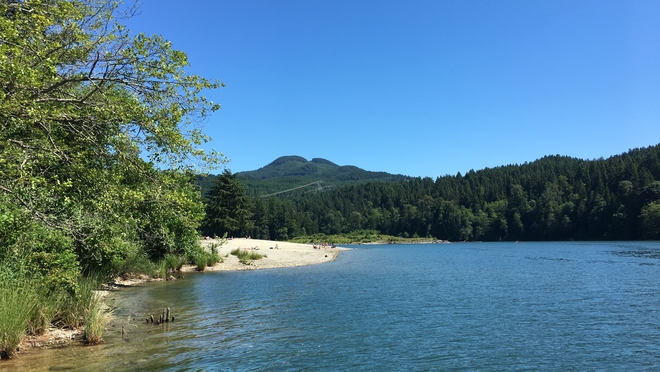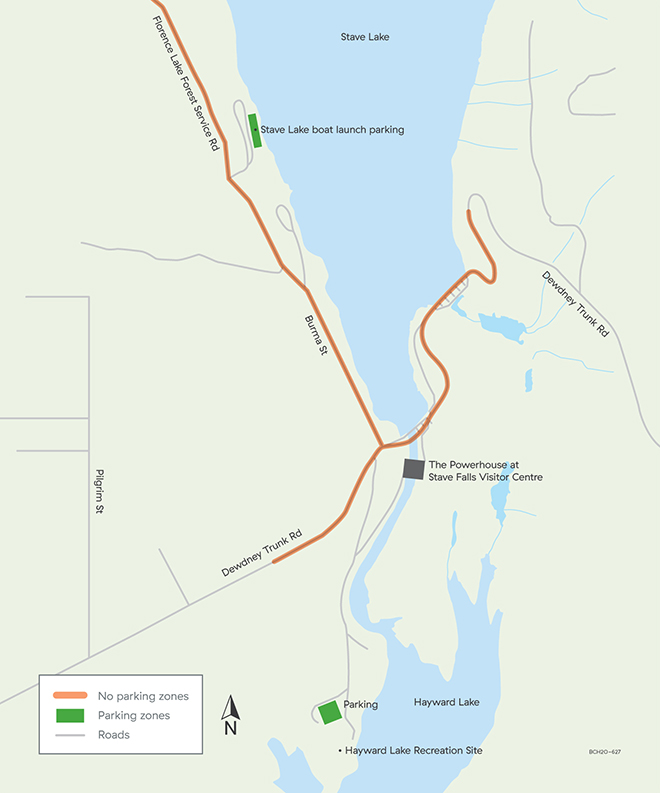Hayward Lake

Wildfire
Wildfire standard notice
- Box Color
- bg-quartz
- Header
- Area notices
- Description
-
Parking notice
We are working closely with the City of Mission to help manage congestion and improve public safety in the Hayward Lake area.
Starting May 1, the City of Mission will implement no parking and towing along city roads leading to Hayward Lake. Please keep emergency access routes clear and do not park in unauthorized areas.
Hairsine Bridge Replacement Project
Construction on the new Hairsine Bridge is underway and we are targeting end November for its completion. Please respect all access restrictions, both at Hayward Beach and in Hairsine Inlet, so we can safely complete this work.
Hayward Lake can get very busy
In the north central Fraser Valley is BC Hydro's Stave River hydroelectric project. The Stave Lake reservoir is bounded by the Stave Lake Dam. Downstream is the Hayward Lake reservoir and the Ruskin Dam. Hayward Lake reservoir is an active source of hydroelectric power as well as an enjoyable recreation area for visitors.
Hayward Lake is located on the traditional territory of Kwantlen First Nation, Musqueam Nation and Stó:lō First Nations.
Parking guidelines
Hayward Lake is one of our most popular recreation sites. Parking is available on a first come, first served basis and we encourage visitors to arrive early to find a spot. During the warmer months the parking lot fills up by early morning. Please note re-entry is not permitted.
Once the parking lot is full, site wardens are required to close the gate until enough spaces are available to handle visitor capacity for the rest of the day. Parking lots may have spaces available while the gates are still closed. Vehicles left overnight may be towed at the owner's expense.
We limit visitor parking to ensure emergency vehicles have access to the site.
Long line-ups can block Dewdney Trunk Road which blocks emergency vehicle access to the site and blocks other traffic from passing through the area. In cooperation with the Mission RCMP who have policing authority for the area, we don't permit line-ups for parking.
Drop-offs and pick-ups cause line-ups, increases traffic hazards, and prevents emergency access to the site.
Directions, hours and what to do at Hayward
Get Google Map directions to Hayward Lake Recreation Area.
About 60 km east of Vancouver, near Mission, you can find a variety of BC Hydro facilities and sites, including Hayward Lake reservoir, the Power House at Stave Falls Visitor Centre, and the Stave Lake boat launch.
See a map detailing recreation sites and other features in the area.
Hayward Lake recreation area generally remains open year-round, road and weather conditions permitting. Please refer to the table below for the year-round operating hours.
| Dates |
Open | Close |
|---|---|---|
| January 1 to February 5 | 8 a.m. | 5 p.m. |
| February 6 to March 11 | 8 a.m. | 6 p.m. |
| March 12 to April 30 | 8 a.m. | 8 p.m. |
| May 1 to September 4 | 8 a.m. | 9 p.m. |
| September 5 to September 25 | 8 a.m. | 8 p.m. |
| September 26 to October 15 | 8 a.m. | 7 p.m. |
| October 16 to November 4 | 8 a.m. | 6 p.m. |
| November 5 to December 31 | 8 a.m. | 5 p.m. |
Facilities at Hayward Lake include:
- Open grass areas
- Car-top boat reservoir access ramp to high water
- 90 m long developed beach
- Wheelchair accessible facilities
- Washroom facility complete with change rooms and beach shower
- Drinking water
- Off-leash dog area (please note that dogs are not allowed at the main beach area)
- Garbage and recycling containers
Please deposit all refuse in the containers provided.
You can enjoy a variety of activities including:
- Hiking and mountain biking trails
- Canoeing and other non-motorized or electric motorboats (motorized boats are permitted on Stave Lake)
- Fishing
The Hayward Lake reservoir recreation area offers a hiking trail to suit you. The 10 km Reservoir Trail connects with the 6 km Railway Trail to provide a scenic 16 km walk around Hayward Lake reservoir.
The Railway Trail, on the west side of the reservoir, was built to accommodate both hiking and biking. The Reservoir Trail on the east side is restricted to hiking only. Trails are closed to all motor vehicles including motorbikes, ATVs, Segways, and scooters.
Please stay on established trails. Take only photos. Leave only footprints and enjoy your hike.
Site safety
Fire restrictions
Charcoal barbecues and gas firepits are not allowed, only propane barbecues are permitted. No open fires allowed. When fire danger ratings are high all barbecues use may be banned, and Trail closures may be put into effect. Notifications will be posted on Hayward Lake websites and within the site.
Please remove all used or empty propane cylinders from the recreation area and take them to an appropriate recycling facility. Contact Recycling BC at 604 732 9253 to find a location near you.
Smoking is prohibited throughout the area.
Wildfire updates
The BC Wildfire Service implements fire restrictions and manages wildfire response. Be sure to check fire bans and restrictions before you visit.
For up-to-date information on wildfire safety, including fire danger ratings and regional fire restrictions call 1 888 336-7378 (3FOREST).
Report a wildfire
To report a wildfire irresponsible behaviour that could start a wildfire call 1 800 663-5555 toll-free, or *5555 on a cell phone as soon as possible. Any information you can provide is helpful, including answering these important questions.
Avoid the designated hazard areas above and below Stave Falls and Ruskin Dams and obey all posted signs. Water releases occur downstream and strong surface and underwater currents are created upstream. Swimming, boating or fishing in these areas is extremely dangerous.
On Stave Lake reservoir, fluctuating water levels may create dangerously shallow channels for boats and expose stumps that are normally hidden. Floating debris may also be encountered.
Shoreline users need to be alert
Changes to Stave River levels occur suddenly and without warning. Flooding may occur in low-lying areas and create dangerous conditions for fishers and other shoreline users.
For your own safety, observe posted signs and be aware of rising water levels. All bodies of water (lakes, rivers and streams) represent a potential danger.
Boating and canoeing safety: Use approved life jackets
- An approved personal flotation device (PFD) is required by law for each person on board any boat or canoe. This includes inflatables. Remember, it won't work if you don't wear it. A sound signalling device, such as a whistle, is also required by law.
- Review Transport Canada's Safe Boating Guide
- Don't overload your boat or canoe with people or gear.
- Be mindful of the weather. Check the forecast before starting out. Be alert for the wave, wind, cloud changes that signal bad weather approaching.
- Cold water robs body heat 25 times faster than air at the same temperature. Stave Lake Reservoir, Hayward Lake Reservoir and the Stave River are cold enough to threaten your survival. Wearing your PFD increases your survival time.
- Plan to be off the water at least 30 minutes before posted closing time. Don't get locked inside the gate.
Hayward Lake
We have lifeguards from the Lifesaving Society of B.C. patrolling a designated area of Hayward Lake during peak times (weather dependent). Visitors should refer to posted signage to determine if lifeguards are on duty. Typical lifeguard hours:
- May long weekend until June 30: weekends from 11 a.m. to 6 p.m.
- July 1 to September long weekend: daily from 11 a.m. to 6 p.m.
While lifeguards can help improve public safety, lifeguards will only be able to monitor a designated area of the site and visitors are reminded to always use caution around water and wear a PFD.
Stave and Ruskin Recreation areas
There are no lifeguards at Stave and Ruskin recreation areas. In the event of an accident, contact the recreation area staff and call 911. Visitors are required to obey the safety directions of all onsite BC Hydro staff or leave the recreation area.
Never leave children without proper supervision while they are in or near the water. Children or non-swimmers should wear a PFD.
Water quality information
Information on the status of water quality can be found on the Fraser Health Authority website.
This recreation area has trails that cross onto property not maintained by us, which may have hazards such as unsafe bridges, rock falls, and rough terrain. Visitors access these trails at their own risk so please ensure you plan your hike accordingly.
Bring hand sanitizer or sanitizing wipes and practice safe hygiene. If you're feeling sick, please stay home.
Consumption of alcohol and drugs is prohibited on BC Hydro property and is strictly enforced by the RCMP. Personal belongings may be visually searched to ensure compliance with site rules. Non-compliance may lead to being removed from the premises.
Pets must be on a leash at all times and are prohibited on the Hayward Lake reservoir beach area. No pets are allowed in the picnic areas.
Five minutes from the main picnic area, there is a dog beach with off-leash areas, picnic tables, pit toilets, and garbage cans.
Firearms and hunting are prohibited in the recreation area.
History & hydroelectric operation
Hydroelectric developments were instrumental in shaping the history and landscape of the Stave Valley from as early as 1909 when the Western Canada Power Company Limited began the construction of a power plant at Stave Falls. Construction of the Stave Falls Dam and Powerhouse began in 1909 and was completed by January 1, 1912.
From 1926 to 1928, the construction of an earthfill dam, tunnel and Powerhouse saw the completion of the Alouette component of the regional hydroelectric system.
In 1929, construction began on Ruskin Dam and Powerhouse at the narrow granite gorge 5.6 km downstream of Stave Falls. This development created Hayward Lake Reservoir, named after Stave Falls Dam's first production superintendent.
An additional generator was installed in the Ruskin Powerhouse in 1950 to meet increased electrical demand in the region. Electric power produced at the Ruskin Generating Station is used to meet short term peak electrical demand in the Lower Mainland.
In January 2000, an upgrade to the Stave Falls Dam and Powerhouse was completed to increase the Dam's efficiency while ensuring long-term hydroelectric service.
The Alouette-Stave-Ruskin generation system is a source of hydroelectricity for the Lower Mainland. Water from Alouette Lake is directed by tunnel to the Alouette Powerhouse on Stave Lake Reservoir where it then passes through the Stave Falls Powerhouse, and into Hayward Lake Reservoir.
From here, water flows through the Ruskin Powerhouse and eventually down into the Fraser River. Together, the three Powerhouses have a production capacity of 203.6 megawatts of electricity.
